I Accidentally Hit Hide Account on Mint... How to See Them Again?
Linux Mint - one of the most beloved Linux distros continues to amaze u.s.a. with each new release. In this mail, we will take a expect at fundamental 25 things to do after installing the well-nigh recent Linux Mint 20 "Ulyana".
Content
- Create Backup
- Configure Update Manager
- Install Drivers
- Configure Hi-DPI display
- Install Codecs
- Install Microsoft fonts
- Subtract Swap usage
- Enable Drive Cache (HDD)
- Optimization for SSD
- Enable Redshift
- Configure Firefox
- Install Google Chrome
- Install Adventurous
- Install pop apps
- Install Clipboard Director
- Configure LibreOffice
- Add keyboard layouts
- Customize Themes
- Xkill shortcut
- Configure sound
- Activate Firewall
- Add/Remove Startup Apps
- Remove some apps
- Extend battery time
- Clean system
i. Create Fill-in
Backup is ever on the height of things to do after installing whatsoever Linux distro. The reason for this shouldn't come equally a surprise. Many things tin go wrong and brand you lose your work. Linux Mint twenty comes with the arrangement snapshot app - Timeshift.
Open Timeshift and click on Wizard in the pinnacle correct corner.
Wizard has the post-obit four steps:
- Snapshot Type
- select RSYNC
- Snapshot Location
- Select the disk where you would like your snapshots to be stored or click Next for the current disk
- Snapshot Levels
- Yous can cull how many snapshots Timeshift will perform/shop on a monthly, weekly, daily, hourly and kicking basis
- User dwelling house directories
- allows you to decide which folders Timeshift volition dorsum upward.
- You should prioritize your dwelling house directory, simply depending on your space, it won't hurt to include
/directory as well.
In case you accidentally lost your information, open Timeshift, click Restore and select a snapshot which contains the files that you would similar to recover.
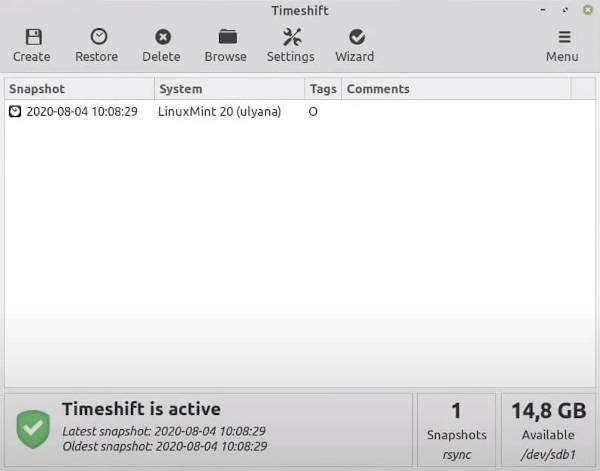
2. Configure Update Managing director
For faster updates, I recommend switching to a local mirror. Open Update Managing director → Edit → Software Sources → Mirrors → Select the closest mirror to your location (for both, main & base) → OK.
To configure the system update frequency, go to Edit → Preferences → Options tab → Adjust the frequency to your liking.
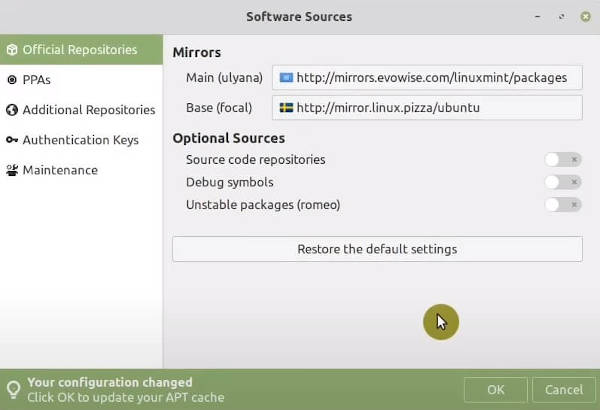
three. Install Drivers
Drivers permit your Linux Mint 20 to communicate correctly with your hardware. Linux Mint 20 comes with a Driver Manager to make installing them a cakewalk.
Open Commuter Director → Select the recommended commuter for your organisation → Employ Changes.

If you don't observe whatever drivers, most likely it is considering your hardware doesn't require any proprietary drivers. Your Linux Mint will use open-source drivers that are already included in Linux Mint 20 "Ulyana".
4. Configure How-do-you-do-DPI display
Present, Hullo-DPI screens are usual. Linux Mint xx has a fraction scaling characteristic to ensure that your desktop displays correctly on those screens.
Open System Settings → Display → User interface calibration → enable Fractional Scaling and select the best resolution for your screen.
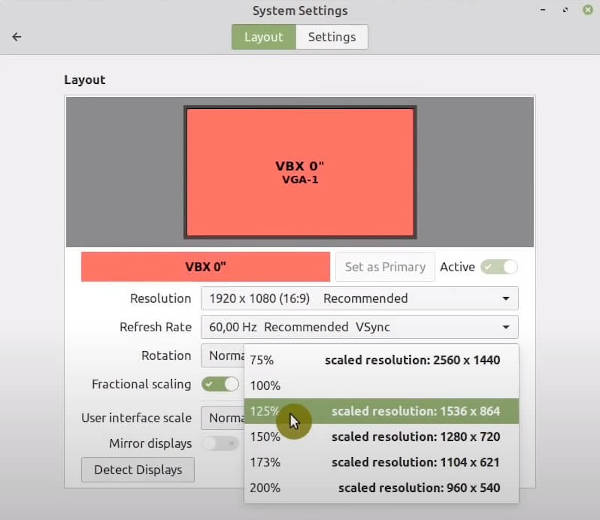
5. Install Codecs
Codec is a piece of software responsible for encoding-decoding multimedia files. They allow you to play diverse media formats on your Linux motorcar.
Open up Carte du jour → Sound & Video → Install Multimedia Codecs._
6. Install Microsoft fonts
If y'all use your Linux Mint 20 for piece of work, you lot'll likely deal with documents. Those documents are ordinarily created in Microsoft Word, and yous guessed information technology - they employ Microsoft's fonts! To install Microsoft's fonts in Linux Mint:
Open Synaptic Package Managing director → Search for mscorefont → Select the package → Right-click → Marking for installation → Apply. s
seven. Decrease Swap usage
One of the means to heave your system performance is decreasing swappiness value. This feature forces your Linux organisation to utilize your RAM, instead of your hard drive. If you are not familiar with Linux swap, check out our post.
Cheque the current swappiness value by executing:
cat /proc/sys/vm/swappiness # 60 (default) Open /etc/sysctl.conf file as an ambassador:
sudo xed /etc/sysctl.conf Add together vm.swappiness=10 at the cease and salvage the file:
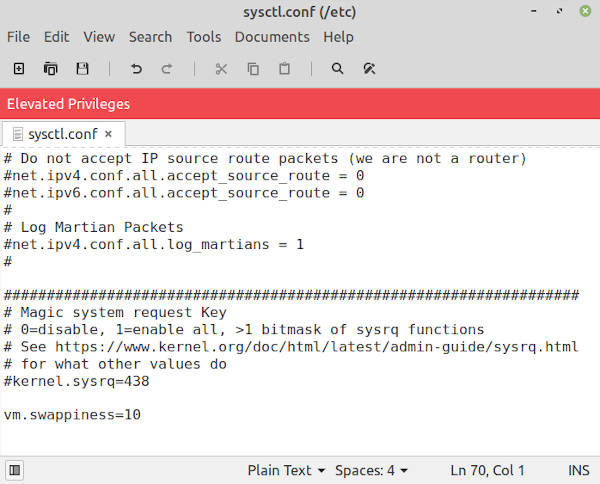
At present reboot your system and bank check the swappiness value:
cat /proc/sys/vm/swappiness It should exist x.
eight. Enable Drive Cache (HDD)
This setting will decrease the delay between writes and improve your arrangement responsiveness. Be aware that there is a potential data loss in the event of power failure. I've been using this feature for years, and I have never experienced any bug, just again, utilise at your own risk.
Open Disks → Select your current HDD → ⋮ (three dots menu) → Drive Settings → Write Cache tab → Enable Write Cache.
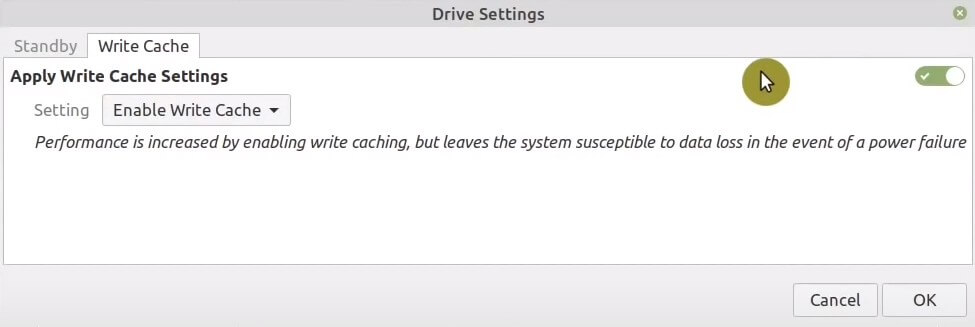
9. Optimization for SSD
Many of y'all are probably familiar with the fact that SSDs wear off over fourth dimension. The best optimization is decreasing the number of writes to increase its lifespan. We have already done the starting time step - reduced swap usage.
Optionally, the adjacent step is to disable the writing of file timestamps.

Open Terminal → sudo xed /etc/fstab → Identify your root partition → Next to the errors=remount-ro add together noatime.
If you have more partitions similar /home, then you'll need to add together this rule to them every bit well. The only exception is the boot partition!
Last, merely not least of import is TRIM. TRIM optimizes the performance and ensures the longevity of your SSD by minimizing write amplification.
Luckily, Linux Mint 20 enables TRIM by default. You can verify it by executing:
sudo systemctl status fstrim.timer You should run across that it is active and enabled.
With these improvements, your SSD volition serve you a long fourth dimension!
10. Enable Redshift
Redshift is a crucial Linux awarding for all of you using your system at nighttime. Redshift protects your eyes by reducing the corporeality of blue lite on your screen.
Open up Redshift from the kickoff menu, and you'll notice the 💡 icon in the system tray. That's Redshift running in the background.
Correct-click on it and make certain you have enabled Autostart to make Redshift run as shortly as your system boots upwards.
11. Configure Firefox
How many times take you accidentally closed your browser and lost all your tabs? If you are like me, it happens so ofttimes. To brand sure that Firefox restores your last browser session every time y'all launch a browser:
Open Firefox → Options (hamburger carte du jour) → Preferences → Enable Restore previous session.

Another useful feature is to enable DRM content. You may find yourself unable to play some videos (e.k. Netflix) or audio because of DRM restriction. To enable DRM content:
Open up Firefox → Options (hamburger menu) → Preferences → Enable Play DRM-controlled content

The adjacent improvement is related to Firefox's search bar behavior. Let's say you search for a particular electronic mail address. Firefox volition open your default electronic mail customer, instead of performing a spider web search. This functionality can certainly exist annoying. To change the search bar:
Open Firefox → Options (hamburger menu) → Preferences → Search tab → Select Add search bar in toolbar

You can also customize the toolbar with Right-click on toolbar → Customize.
Lastly, I'll change the search engine. By default, Firefox on Linux Mint uses Yahoo, but I adopt Google as my search engine.
Open Firefox → Options (hamburger carte du jour) → Preferences → Search tab → Scroll to the lesser → Find more search engines → Roll to the bottom of the page → Click Google.
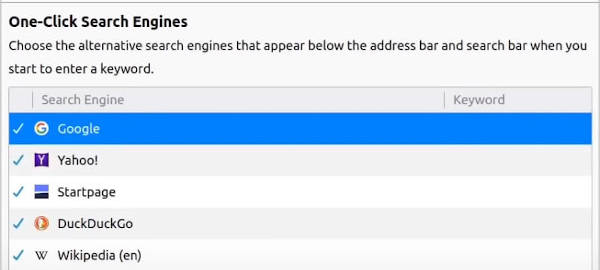
Now, go back to the search tab and choose Google as your default search engine.
These were modest tips that should make your browsing experience a piddling bit better.
12. Install Google Chrome
Although I prefer and recommend using Firefox, being the virtually popular browser nowadays, Google Chrome is a go-to browser for many users. To install Google Chrom in Linux Mint:
Go to Chrome'due south official website → Click Download → Select .deb parcel → Take and Install.
After you accept downloaded Google Chrome, open your file manager in the Downloads directory and double-click on Chrome'due south .deb file to install it.
13. Install Audacious
Linux Mint 20 has chosen Rhythmbox every bit its default music player. Still, I am fond of a simple music player - Audacious. To install Audacious:
Open Software Center → Search for audacious → Select the commencement entry → Install.

14. Install popular apps
Linux Mint's target userbase has always been users coming from Windows. It's no wonder that it comes with a slew of apps to condolement a new user. Equally we take seen from to a higher place, nosotros can use the Software Middle to install additional apps.
Try to search and install some of the popular apps:
- Dropbox
- Zoom
- Spotify
- Steam
- Skype
- Slack
They all are bachelor in the Linux Mint Software Center.
15. Install Clipboard Manager
Linux Mint twenty doesn't come with a clipboard managing director, but zippo stops united states of america from installing information technology ourselves. I like Clipit the virtually.
Open Software Middle → Search for clipit → Install
After yous take installed Clipit, launch information technology, and y'all'll find its icon in the system tray. By clicking on it, you can meet your clipboard history.
To customize how many entries evidence in history:
Right-click on Clipit's icon → Preferences → History tab → Adjust the number of Items in history.
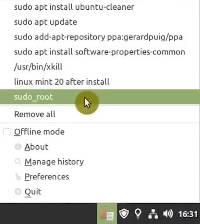
16. Configure LibreOffice
LibreOffice is a well-known office suite culling for Linux. It comes with balanced default settings, but I'll show yous some tips to go far even better. For example, y'all can make your LibreOffice wait similar to Microsoft'south office:
Open LibreOffice Writer → View → User Interface → Enable Single Toolbar & Tabbed interface.

Open LibreOffice Writer → Tools → Options → Icon fashion → Select Colibre.
![]()
Optionally you could experiment with more styles. You lot can install them by opening Synaptic and searching for libreoffice-style.
17. Add keyboard layouts
If you are multi-lingual person, several keyboard layouts is a must-have.
Open System Settings → Keyboard → Layout → + button → Choose a keyboard layout → Add.
Customize the shortcut for switching between layouts:
Go to Options → Switching to another layout → Select your preferred shortcut (ALT + Shift).
Keyboard layout icon in the system tray displays the agile keyboard layout and allows you to switch betwixt your keyboard layouts.
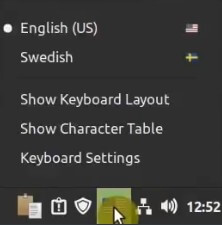
18. Customize Themes
Similarly to other distros, Linux Mint twenty is highly customizable.
Open Arrangement Settings → Themes → Select your preferred Icons and Desktop theme.
On Add/Remove tab, as the name implies, you lot can install/uninstall themes.
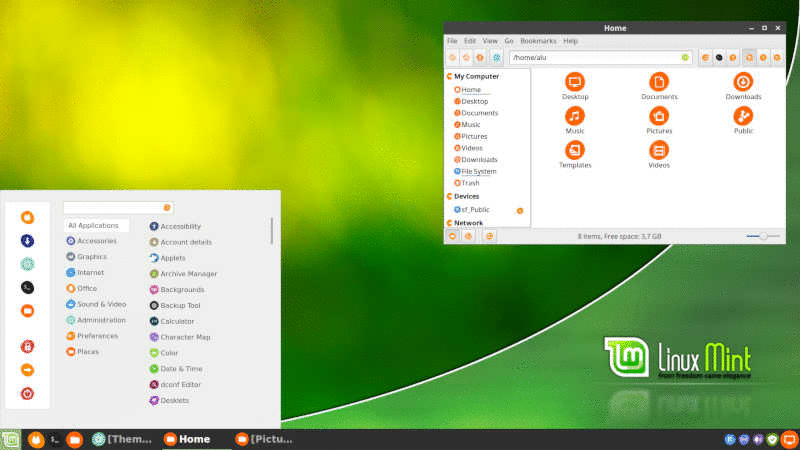
Add together/Remove tab contains just a limited set of themes. To take reward of all available themes, larn how to install additional Cinnamon themes.
19. Xkill shortcut
xkill is a Linux control primarily used to strength-quit unresponsive apps. Some distros practice take a pre-set shortcut for xkill, only Linux Mint 20 does not.
Open Organisation Settings → Keyboard → Shortcuts → Add custom shortcut → Set name to Xkill and control to xkill → Add → Click on Keyboard bindings entry → Type your shortcut (CTRL + Esc).
Next fourth dimension you press CTRL + Esc, your mouse pointer will plough into a cross, and if yous click with this cantankerous on whatever frozen app, it volition force-quit.
xx. Configure audio
Linux Mint twenty sound configurations are placed in the Settings App Sound section. Pulse Audio Volume Control (PAVC) is the standard app for configuring sound on Linux.
For example, if your laptop has repose speakers, PAVC allows you lot to amplify them. To install PAVC:
Open Software Center → Search for pavucontrol → Install.
So adjust the volume to a desired level:
Open PAVC → Output Devices → Drag slider to the correct-hand side to amplify your speakers.
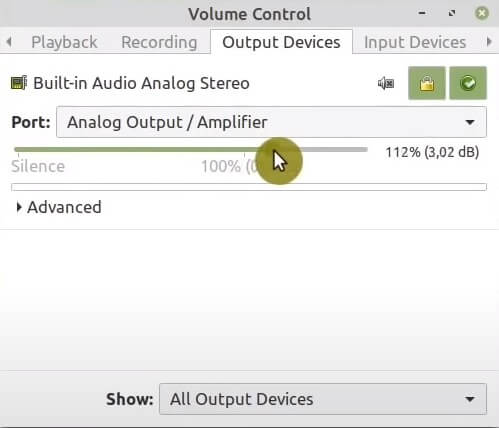
21. Actuate Firewall
While Linux does non need anti-virus, it can surely benefit from a network firewall. Linux Mint 20 bundles Firewall as a network firewall app.
Open up Firewall Configuration → Enable Firewall.
The default settings work fine, simply if you wish to learn more about network firewall in Linux, check out this post on why y'all demand a Linux Firewall.
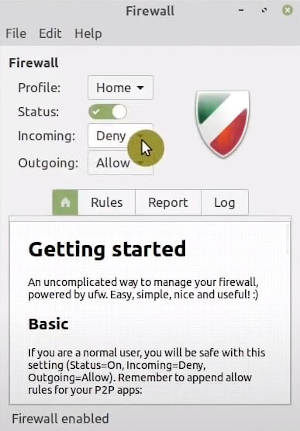
22. Add together/Remove Startup Apps
Linux Mint twenty has quite a few services running at organisation startup. Y'all likely don't need all of them. To boost your system startup fourth dimension, I would recommend you to disable the services you don't need:
Open Startup Applications → Disable services you don't use.
If you lot have an app that you would similar to start at system startup:
Click on the + push button → Choose Awarding → Select an application → Add together Awarding.
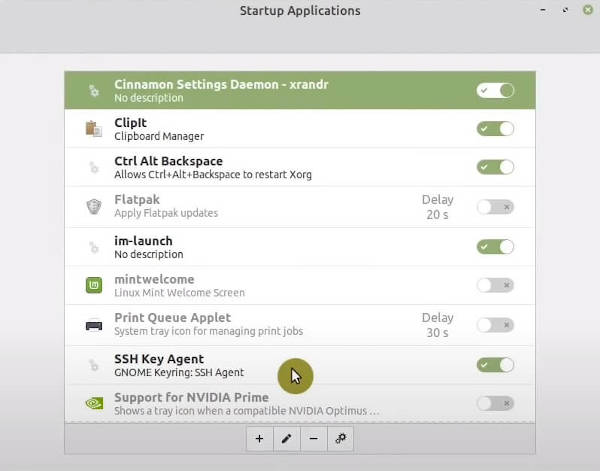
23. Remove some apps
Equally a beginner-friendly distro, Linux Mint 20 bundles all sorts of apps. For some users, this may be as well much. To keep your system clean, you lot might want to remove the apps y'all don't use:
Open Menu → Right-click on an app that you lot would similar to remove → Uninstall.

24. Extend battery time
To meliorate the battery life of your laptop, you don't need to practise more just install the tlp bundle. It is a background software responsible for managing a laptop's battery. You merely need to install it and no other mail-install configuration is required.
Open Synaptic → Search for tlp → Mark for installation → Utilize.
25. Clean organisation
Linux Mint xx packages Bleachbit as a system cleaner app. Bleachbit is a good app, but I've recently tried Ubuntu Cleaner and I liked it more.
Install Ubuntu Cleaner past running the commands below:
sudo apt install software-properties-common sudo add together-apt-repository ppa:gerardpuig/ppa sudo apt update sudo apt install ubuntu-cleaner After you've installed Ubuntu Cleaner, open it & clean redundant files.
If you wish to remove old kernels, I would recommend you to employ Linux Mint'due south Update Director.
Open Update Managing director → View → Linux Kernels → Remove old kernels (brand certain to keep at least 2 kernels).
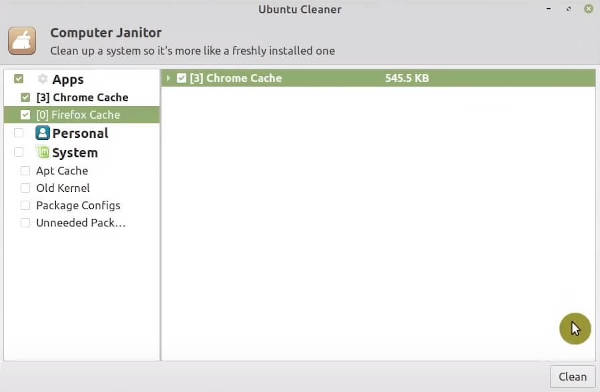
Conclusion
Linux Mint 20 is a stable, familiar-looking and featureful distro. I believe with these 25 things to practise after installing Linux Mint, you would like it even more.
Permit me know if y'all would add together or remove somethings grade this listing. 👇
Source: https://averagelinuxuser.com/linuxmint20-after-install/
0 Response to "I Accidentally Hit Hide Account on Mint... How to See Them Again?"
Post a Comment